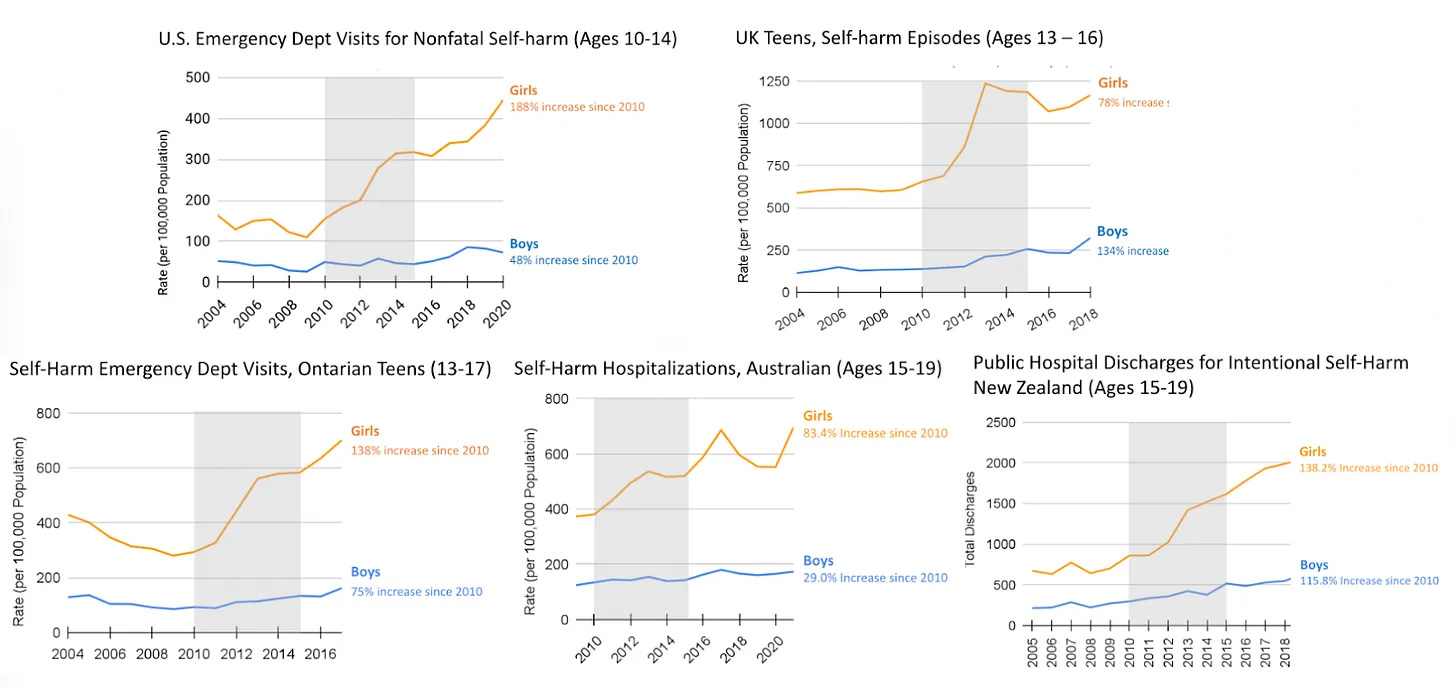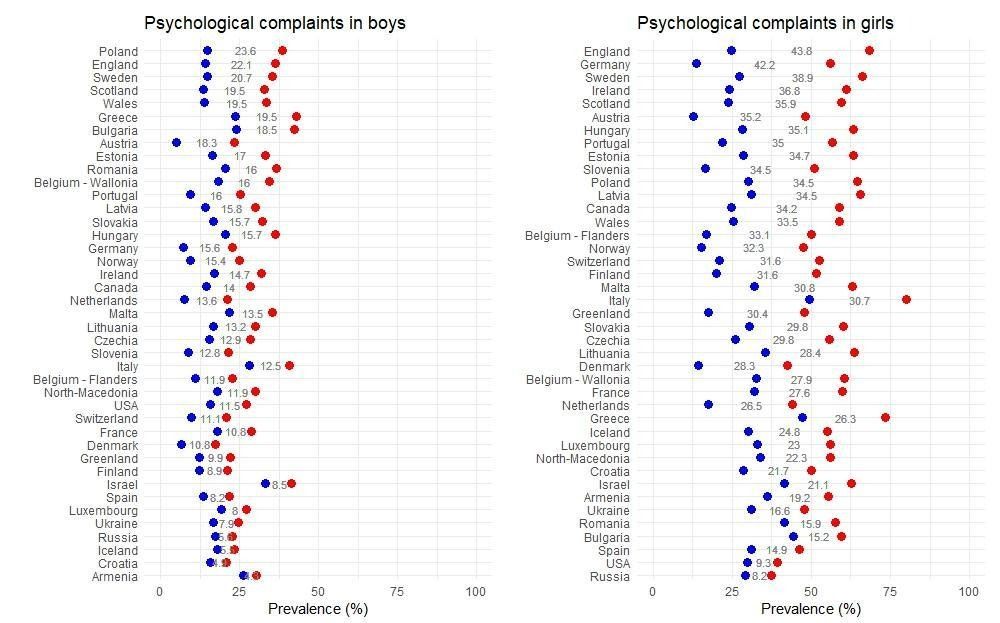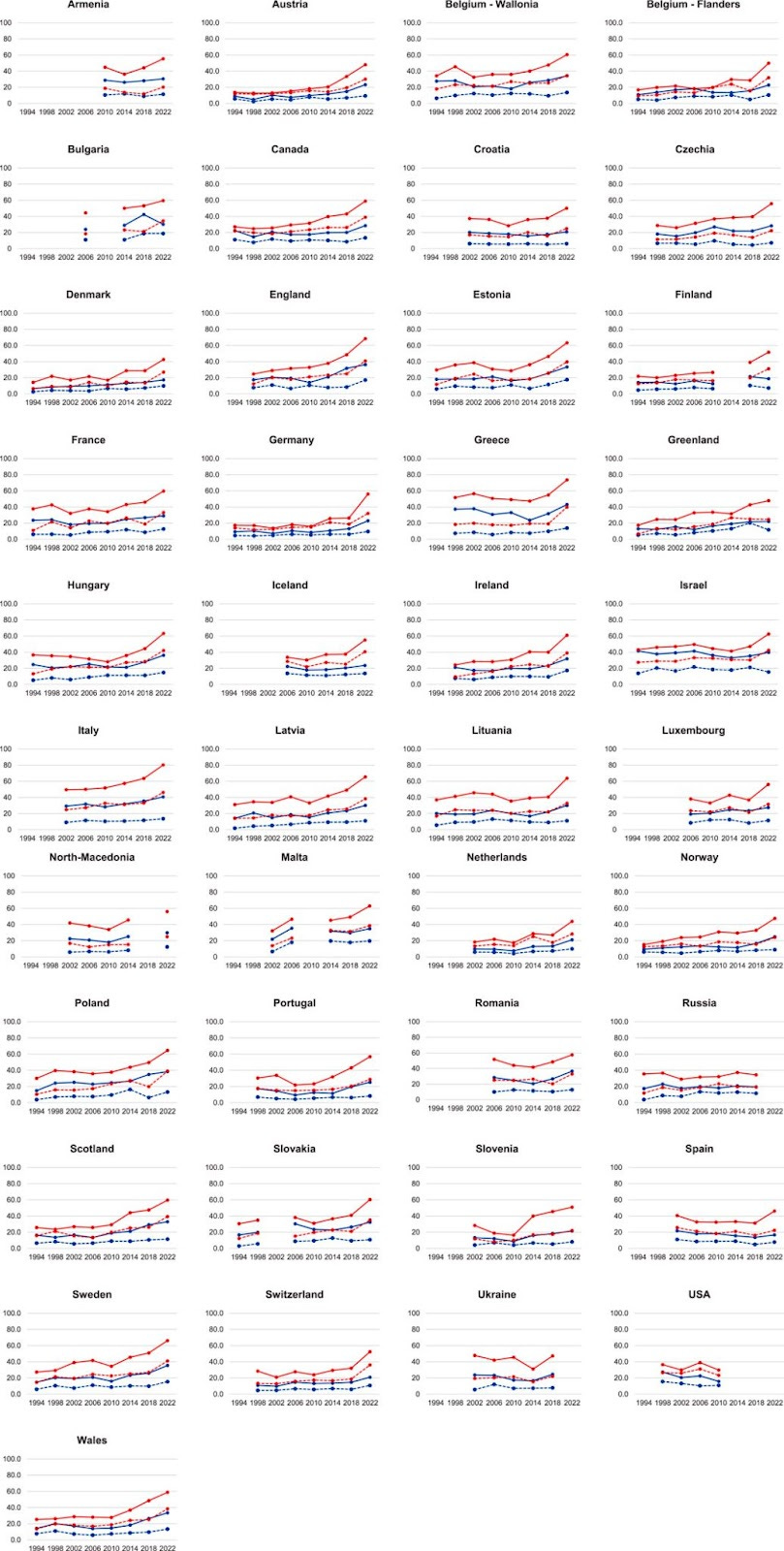How Psychological Distress Globally Accelerated Among Youth During the COVID-19 Pandemic
A Three-Decade Perspective on Escalating International Psychological Distress in Adolescence
Intro from Zach Rausch:
Last year, I began a series of essays exploring whether—and how—the youth mental health crisis is manifesting in various nations around the world. My first post focused on the five major Anglophone countries—the United States, Canada, the United Kingdom, Australia, and New Zealand—and uncovered a similar pattern in all five nations: In the early 2000s, there was little indication of rising distress among teens; after 2010, however, rates of anxiety, depression, and self-harm rose significantly, particularly for girls.
Adolescent Self-Harm Episodes in Five Anglo Nations
Figure 1. Since 2010, rates of self-harm episodes have increased for adolescents in the Anglosphere countries, especially for girls. For data on all sources, and larger versions of the graphs, see Rausch and Haidt (2023). (Data for Canada is limited to Ontario province, which contains nearly 40% of the population of Canada.)
My second post shifted to the Nordic nations—Norway, Sweden, Denmark, Iceland, and Finland—where I found similar patterns of rising distress among teens (though the evidence for increasing self-harm was more mixed). While researching that essay, I came across the work of Thomas Potrebny, Associate Professor at Western Norway University of Applied Sciences, who has spent the past decade investigating youth mental health trends.
Thomas and I worked together to develop an open-source Google Doc to delve deeper into Nordic mental health patterns and, subsequently, broader trends throughout Europe. Together with Jon, we then published another installment examining mental health trends across Europe—finding clear evidence of worsening psychological distress in numerous countries, with the clearest rises occurring in Western Europe. (For more details, please see our previous post, which dives deeper into cross-national variation.)
One gap in our earlier work was the absence of data from the early 2020s, during the height of the COVID-19 pandemic. Now, a newly published paper (co-authored by Thomas) addresses that gap with a stunning conclusion: Mental distress has not only increased in all 41 surveyed countries since 2018, but it has reached its highest levels on record in every country studied.
In this post, Thomas and Karen Schrijvers, a PhD candidate at Ghent University and lead author of that recent paper, will present the paper’s key insights, drawing on both the most up-to-date wave of data and historical information that was previously unavailable in this important dataset.
– Zach
How Psychological Distress Globally Accelerated Among Youth During the COVID-19 Pandemic
Over the past three decades, the lives of adolescents around the world have profoundly changed in the face of social and technological revolutions, along with a global pandemic. The impacts of these events and changes are far-reaching, touching everything from mental health to academic performance. In previous posts here on After Babel, Jon and Zach have explored worsening international trends in adolescent mental health, with a focus on the Anglosphere, the Nordic nations, and Europe more broadly. In this post, we delve deeper into this international phenomenon, drawing on findings from our recently published study in the International Journal of Public Health.
Our research revealed that psychological and somatic (physical) health complaints among adolescents have doubled over the 41 nations over the past three decades (1994-2022). By 2022, nearly 60% of adolescent girls and about 30% of boys now report experiencing multiple mental health complaints each week. The prevalence of these symptoms vary from country to country, but the overall trend is clear and has gotten worse since the outbreak of COVID-19. Although the increase in adolescent distress predates the pandemic, it appears to have exacerbated and accelerated these negative trends. In fact, in 2022, all 41 countries reported the highest prevalence of psychological complaints on record.
International Trends in Psychological and Somatic complaints (1994-2022)
To examine international trends in adolescent health, we used data from the quadrennial Health Behaviour in School-aged Children (HBSC) survey from 1994 to 2022, which included 470,797 15-year-olds from 41 countries around the world.1 We focus on 15-year-olds because previous research has shown that this age group has the highest prevalence of psychological and somatic distress, the greatest cross-national variation, and the largest gender differences in the available data.
We used the HBSC Multiple Health Complaints Scale to measure psychosomatic distress, a broad, non-clinical instrument designed to measure the frequency of health complaints among adolescents. This scale is widely recognized as a valid and reliable measure that is consistent over time and comparable across countries. The scale captures two dimensions of distress: psychological (e.g., feeling low, irritable, nervous, and experiencing sleep difficulties) and somatic (e.g., headaches, backaches, stomachaches, and dizziness). Adolescents were asked how often they had experienced these symptoms each week over the previous six months. For our analysis, we categorized their responses and defined two or more weekly complaints as the threshold for our primary prevalence outcomes for both psychological and somatic distress. For comparison with previous posts from After Babel, we also present the general trend data on those experiencing three or more symptoms per week.
By 2022, nearly 60% of adolescent girls and about 30% of boys now report experiencing multiple mental health complaints each week.
Our study found that psychological and somatic complaints among adolescents have doubled worldwide since the 1990s. However, as shown in Figure 1 and 2, this increase has not followed a steady linear pattern. Before 2010, trends differed from country to country, with stable, slightly increasing, and decreasing trajectories all represented in roughly equal measure. In most countries, complaints began rising after 2010. The pandemic then accelerated this trend, leading to an even steeper increase between 2018 and 2022.
Psychological complaints not only occur more frequently than somatic complaints but have also increased more sharply since 2010. Although somatic complaints have remained comparatively stable, they too have risen notably during this period. Moreover, girls consistently report higher distress levels than boys, underscoring significant gender differences in adolescent mental health.
Increases in 2+ Weekly Health Complaints in 41 Countries (1994-2022)
Figure 1: Trends in two or more complaints more than once a week (boys on the left; girls on the right). Psychological complaints are in blue, while somatic complaints are in orange. (1994-2022). Data can be found in the supplementary material of the paper (Table S2).
Increases in 3+ Weekly Health Complaints in 41 Countries (1994-2022)
Figure 2: Trends in three or more complaints more than once a week (boys on the left; girls on the right). Psychological complaints are in blue, while somatic complaints are in orange. (1994-2022).
Cross-National Variations in Prevalence rates of Psychological and Somatic Complaints
Although there has been a general increase in psychological and somatic complaints among adolescents worldwide, there is considerable variation between countries.
For example, the lowest recorded prevalence of somatic and psychological complaints at the country level varied by country and year, typically occurring sometime between 1994 and 2014. Notably, however, all 41 countries reported the highest prevalence of psychological complaints in 2022, reflecting a global change in prevalence rates.
Notably, however, the absolute rates of distress vary substantially across nations. Italy, for example, recorded the highest prevalence of 2+ psychological complaints among girls in 2022 (82.2%), while Denmark reported much lower rates (42.6%) (see Figure 3). Although these are the highest recorded rates for both countries, such large differences between countries highlight how cultural, societal, technological, and economic factors might shape adolescent mental health differently in each country.
In 2022, all 41 countries reported the highest prevalence of psychological complaints on record.
The following figure shows the highest and lowest reported prevalence of 2+ psychological complaints in each country. Blue dots represent the lowest prevalence, red dots the highest, and the size of the gap between them is shown in gray. Countries are ranked in descending order by the size of the prevalence gap.
Highest and Lowest Prevalence of 2+ Weekly Psychological Complaints in 41 Countries between 1994 and 2022
Figure 3: Difference between highest and lowest prevalence over the years of two or more psychological complaints more than once a week for the last six months by gender and country.
This figure shows that, on average for any given country, whether we look at the year with the lowest rate of complaints or the year with the highest rate of complaints, girls tended to report more psychological complaints than boys. Additionally, for any given country, on average girls' complaints increased more (between the year of lowest complaints and the year of highest complaints) than boys. It also highlights cross-national differences, not only in the size of this gap, but also in the highest and lowest prevalence rates. For example, the lowest prevalence in Greece exceeds the highest prevalence in the Netherlands, illustrating the wide variation in adolescent mental health across the world.While there is likely less variation between regions than between countries, as Jon and Zach have found previously, we did not investigate this further in this article.
The Importance of Examining Country-Specific Trends
Figures 1 and 2 illustrate the global increase in psychological distress over time. Looking closer at these figures, they reveal an important pattern: the increase in psychological distress appears to be closer to multiplying rather than following a steady, linear trend. We examined what trend patterns occurred within each of the 41 countries over the three decades and observed 4 common patterns: stability over time, linear increase, U-shaped trends, and cubic (increases followed by decreases). Notably, across most countries, stability and linear increases (1994-2018) often became U-shaped or cubic (1994-2022), also illustrating the rapid growth that, in many countries, was more clearly established after 2018.
However, many cross-country differences were also observed. For example, some countries, like Italy, show a linear increase over time with more rapid growth towards 2022, while others, like Portugal, already showed this U-shaped rise in distress levels even before 2022 and this growth continued with COVID. You can see the wide variety of trends in Figure 4 below.
Trends in 2+ Weekly Psychological Complaints in 41 Countries
Figure 4: Prevalence of two or more psychological and somatic complaints in boys and girls by country and year (Health Behaviour in School-aged Children study, 1994–2022 for 41 countries). Notes: Solid lines represent prevalence rates for psychological complaints, while dotted lines indicate prevalence rates for somatic complaints. Blue lines represent boys, red lines represent girls.
Given the different trends and varying prevalence of psychological distress today, it is important to amend solutions to align with the unique needs of each nation. Tailored and country-specific approaches are essential for addressing the growing burden of adolescent distress.
Conclusion
The steep rise in adolescent mental health problems over the past decade is a global wake-up call, underscored by the post-pandemic acceleration of the pre-existing problematic trends for girls and, in many cases, the beginning of an increase for boys. Although concerns around youth mental health were growing long before 2022, COVID-19 and the related social measures (i.e., lockdowns, school closures, and prolonged screen-based activities), and the global economic recession that followed, have likely amplified underlying issues.
Although nations differ to some extent, we must now face the reality that a generation of young people are experiencing significant mental health challenges, which are likely to have lasting consequences for individuals, health care systems, and society. It is crucial to remember that these are modifiable problems and that by intervening on the current negative trajectories of adolescent mental health, we can turn things around.
Armenia, Austria, Belgium – Flanders, Belgium – Wallonia, Bulgaria, Canada, Croatia, Czechia, Denmark, England, Estonia, Finland, France, Germany, Greece, Greenland, Hungary, Iceland, Ireland, Israel, Italy, Latvia, Lithuania, Luxembourg, North-Macedonia, Malta, Netherlands, Norway, Poland, Portugal, Romania, Russia, Scotland, Slovakia, Slovenia, Spain, Sweden, Switzerland, Ukraine, USA, Wales.










Stress caused by whom? Oh right, the media+government+WEF:
New Normal ● Alone Together ● Build Back Better ● Flatten the Curve
Stay Home Save Lives ● Protect/Save the NHS ● We’re all in this together
Test, Trace, Treat ● Stay smart, Stay Safe, Stay Open ● We Stay Home!
Don’t Panic, Don’t Rush, Don’t Overstock ● Only You Can Prevent the Spread
Stay Home, Your Home is Your Lifeline ● Stay Home, Save Lives, Avoid Stage 5
NHS: We Stay At Work for You – You Stay At Home For Us ● COVID Ends With You
Follow The Science ● Trust The Science ● Believe In The Science
Be Informed, Be Prepared, Be Smart, Be Safe: Be Ready to Fight COVID-19
Don't do your own research ● We're your one source for truth ● Ask your doctor
The vaccine will save us ● The booster will save us ● The 4th dose is the answer
Your freedom ends where your contagion begins ● Self Isolate!
I wear my mask to protect you and you wear your mask to protect me
There is no evidence of harm ● This is a pandemic of the un-vaccinated
Out of an abundance of caution ● No one is safe until everyone is safe
This is for the greater good ● It is Safe and Effective ● The science is settled
THE SCIENCE IS YOUR NEW GOD AND IT IS WHAT WE SAY IT IS
These are not science terms and phrases. They are hypnotic chants meant to induce an audience into a suggestive state of mind – this is why they are repeated over and over and over again.
Furthermore, masking has historically been an integral part of an initiation ritual: in our case the initiation into the “new normal” the globalists have planned for us.
Put another way—all of this was one giant world-wide psychological operation. Here is a collection of authorities admitting this with its horrible effects woven through them. Take the time to read through this–the crimes are horrible. But first, to put these horrors into context, COVID-19 posed practically no risk to anyone, and yet we were blitzed with fearmongering at every turn: https://tritorch.com/covidhypnosis
The best way we can beat the trend is by swimming upstream, not looking at screens first thing in the morning, and marching our children and ourselves out for that Sunrise. Then watch the stats swing back in our favor.